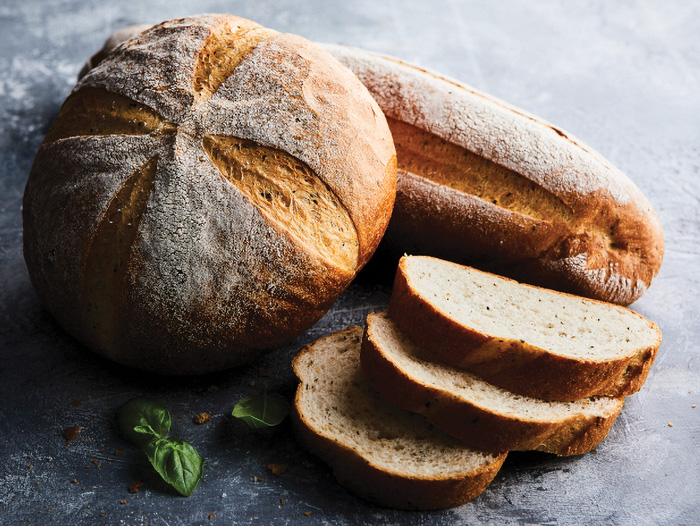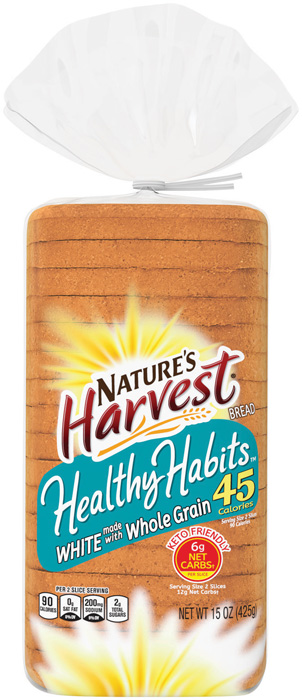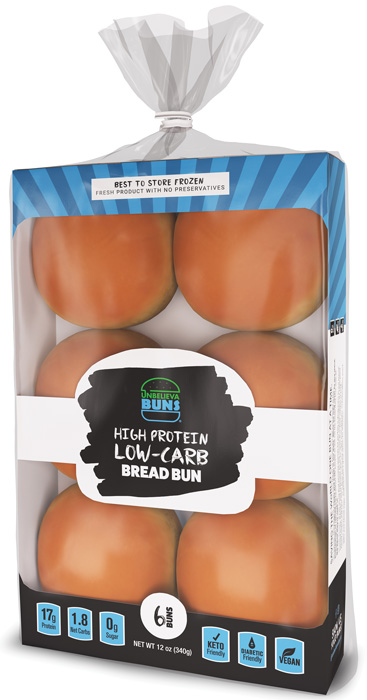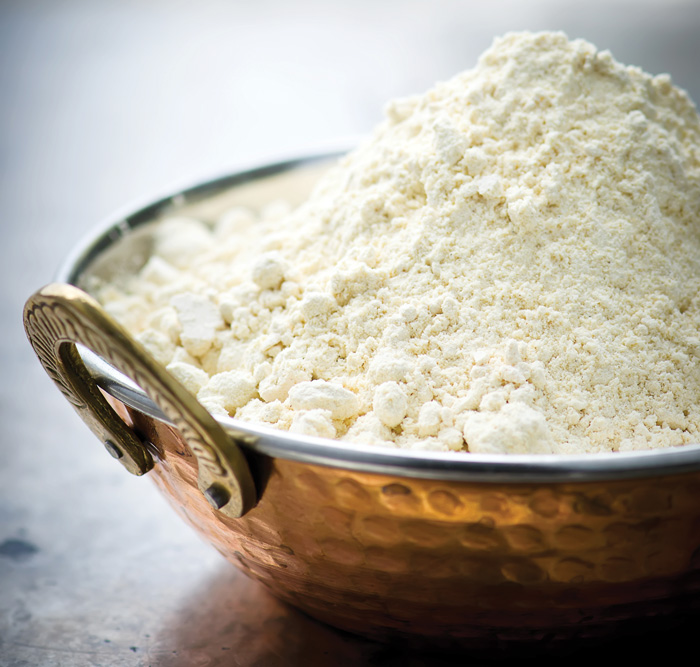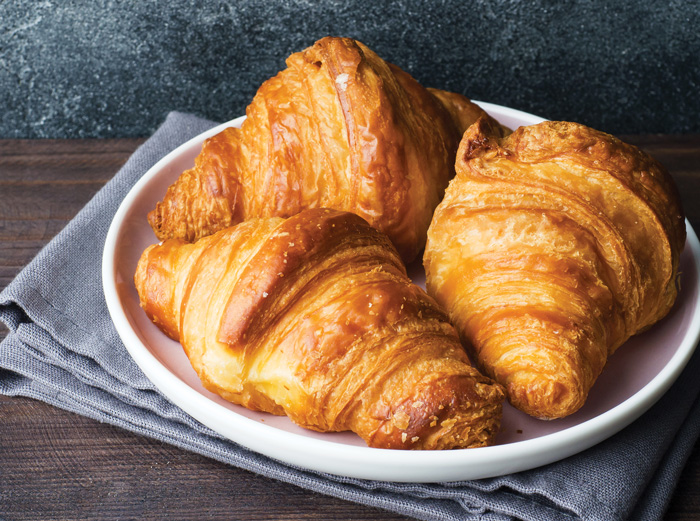Better-for-You Bakery Products: 7 Top Trends
INGREDIENTS
While it’s true that pandemic stressors may have had many of us finding comfort in a big hunk of bread or a handful of cookies, it’s also true that more and more consumers are looking to foods to help boost their health. In fact, one in five is actively seeking health benefits from foods, according to the International Food Information Council’s (IFIC) 2021 Food & Health Survey.
Weight loss/weight management, energy/less fatigue, digestive health, and heart/cardiovascular health are the top four benefits consumers seek, IFIC found. Consumers also have definite ideas about what they’re looking for: 27% define “healthy food” as products that contain certain components such as nutrients, whole grains, high protein, and/or high fiber, while 25% say “healthy food” does not contain or has low levels of components such as sugar, fat, and carbohydrates.
Given this focus on healthful eating, it’s not surprising that bakery product formulators are working to help consumers cut carbs, reduce sugar, pump up their protein intake, and more. Let’s take a look at seven key better-for-you bakery product trends and some ingredients that allow product developers to meet consumers’ expectations for health, taste, and function.
1) Plant-Based Popularity
Nearly 60% of consumers say they “strongly agree” or “somewhat agree” that their eating habits are increasingly shifting to plant-based, according to a national general population survey from OnePoll last fall. And SPINS reports that sales of overall foods and beverages positioned as plant-based were up 29% for the year ended Dec. 27, 2020, with $5.6 billion in sales in multi-outlet, specialty, and natural channels.
“There is strong interest in plant-based bakery options,” says Sheila McWilliams, technical sales manager at Fiberstar. “The plant-based trend is the next iteration of vegan product options in the bakery space, and they must deliver on taste.”
In fact, plant-based positioning is a natural for bakery products, suggests Kathy Sargent, director of global market strategy at Corbion. “Bakery is primarily plant-based already,” she says. “Some [vegetarian/vegan] consumers just want a few ingredients replaced. [Or we can add] new on-trend ingredients like legumes or vegetables that add a little bit more of a health benefit with a plant-based halo. It adds to the excitement of trying something new.”
Kellogg subsidiary RXBAR, for example, in June launched its first plant-based product, RXBAR Plant in peanut butter and chocolate chip flavors, using pea and almond protein rather than egg whites.
Going vegan can present some of the toughest challenges for plant-based bakery formulations. “Eggs and dairy ingredients provide texture, mouthfeel, flavor, bulk, and shelf life to bakery products,” says Peggy Dantuma, business development director, bakery, at Kerry North America. “All these aspects need to be addressed when removing these highly functional ingredients. ... The degree of difficulty will be determined by the end application.”
Proteins such as wheat, soy, flax, and pea can be used in combination to replace eggs or dairy proteins, Dantuma explains. “Typically, a hydrocolloid such as CMC [carboxymethyl cellulose], xanthan, or guar gum would be used in combination with a protein source to improve functionality,” she says.
“Replacement of eggs in bakery has been an ongoing technology challenge because eggs have so many functions,” agrees Jeff Casper, director of research and applications at Merit Functional Foods. In April, Merit achieved first commercial production of its novel lineup of Puratein canola plant proteins, which can provide critical functionalities required for vegan bakery applications, says Casper.
“We’ve seen a lot of success using [Puratein C] in the development of egg-free high ratio cakes with excellent volume, symmetry, cell structure, and final texture,” he adds. “Puratein C and G offers egglike functionalities, including the unique ability to whip and incorporate a large degree of air into food formulations. And when combined with the gelation functionality, it can set into a stable crumb.”
2) Carb-Cutting Keto
The low-carbohydrate, high-fat keto diet is on a roll, with the global ketogenic diet market projected to grow from $10.2 million in 2019 to $15.3 million by 2027, a compound annual growth rate (CAGR) of 5.3%, according to The Insight Partners market research firm.
Trimming carbs from carb-heavy bakery products while maintaining quality can be accomplished by replacing regular flour with a high-fiber source and modified starches, says Anita Srivastava, senior technical services manager, bakery, at Kemin.
“Since the regular starch [in regular flour] has high glycemic index, the [regular] flour is typically replaced by bran and other sources of fibers to provide the bulk of the formulation,” Srivastava says. “This bulk will provide varying levels of dietary fiber with low to no calories. This also affects the textural properties of the finished product. Due to the high water absorption capacity of fibers, they compete with gluten for water, which affects the gluten hydration and complete gluten development. Generally, the higher the presence of fiber in a dough, the higher the amount of water required in order to obtain a workable dough.”
In March, Ardent Mills launched Keto Certified Net Carb Flour Blend in white (all-purpose) and specialized flour blends for a broad range of applications including breads, buns, rolls, bagels, pizza, and sweet goods. Keto certified by the Paleo Foundation, the flour blend is nut free and contains gluten, allowing food companies to run it on their current equipment without any changes.
“It offers a highly nutritious fiber portion that aligns with the principles of a keto-friendly diet,” says Ken Ruud, director of innovation at Ardent Mills.
Bread makers have lost no time getting in on the low-carb action. In June, Bimbo Bakeries USA added the first Healthy Habits brand keto-friendly bread product, Healthy Habits white bread made with whole grain, containing 6 net carbs per slice. Natural Ovens Keto-Friendly Hot Dog Buns rolled out in May with 26 g carbs and 25 g fiber per serving. On the snack side, PepsiCo’s Hilo Life, part of the food giant’s internal brand incubator, launched keto-friendly tortilla- style chips in March made with defatted almond flour. The snack chips provide 3 g net carbs per serving.
3) Less Sugar in the Mix
Sugar is the top item that consumers who read Nutrition Facts labels look for (57%), reports NPD, and the number of Americans limiting or avoiding sugars in their diet has remained stable at a high level (72%) since 2020, according to IFIC’s 2021 Food & Health Survey.
Successfully formulating reduced-sugar baked goods, however, requires addressing all areas where sucrose plays a role, says Michael Merkley, senior scientist, bakery, NOAM at Tate & Lyle. “Leveraging an ingredient toolbox approach with multiple solutions for sweetness and texture is critical to maintain product integrity in bakery products,” he says.
“Sugar reduction in bakery products can be especially challenging given sugar’s functional role in many formulations,” says Tim Christensen, senior food technologist, R&D bakery applications at Cargill. “[But] we’ve found developers can achieve modest reductions of 15% to 20% in cookies and 20% to 50% in cakes and muffins using ingredients like stevia leaf extract, erythritol, and chicory root fiber, with limited effect on overall product performance.”
Mondelēz International subsidiary Hu Products, for example, unveiled a line of no-added-sugar cookies in March made with chicory root fiber, cassava flour, dates, organic coconut oil, cashew flour, flaxseed, sea salt, and organic rosemary extract. Each serving contains 6–7 g sugar, and the cookies are available in chocolate chip, peanut butter, snickerdoodle, and ginger snap varieties.
“Low- and no-calorie sweeteners like allulose, stevia, and monk fruit continue to grow in popularity as an alternative to sugar in baked goods,” says Nancy Hughes, president of Apura Ingredients. “Allulose has been receiving the most interest, particularly in the baked goods sector. It offers many of the same functional benefits as sucrose but with only 10% of the calories.”
While monk fruit and stevia have given formulators more options for replacing sugar with natural alternatives, both lack the bulk that sugar provides, says Sheri O’Brien, vice president, sales and marketing at BioNeutra North America. “Many formulators have found success blending these ingredients with an IMO [isomalto-oligosaccharide]-based sweetener as the binder or bulking agent,” says O’Brien.
Last fall, BioNeutra introduced VitaFiber PLUS, an IMO-based sweetener with a dietary fiber approved by the U.S. Food and Drug Administration that can replace sugar as a binder or filler in protein bars, snacks, and other baked goods while also boosting fiber content in a formulation.
When reducing sugar and other carbohydrates in bread, volume will decrease due to lack of carbohydrates for yeast activity and lack of structure, says Kerry North America’s Dantuma. The sweetness is typically replaced with high-intensity sweeteners such as sucralose, stevia, or ace-k, she says, and bulking agents can be fibers, resistant starches, sugar alcohols, or low-calorie sweeteners such as allulose.
4) Pumped Up Protein
Protein continues to be a buzzword among the health and weight conscious, thanks to its reputation for satiety. IFIC’s 2021 Food & Health Survey reports that 62% of consumers say they are trying to consume protein. Meanwhile, the global protein ingredients market is expected to expand at a CAGR of 10.5% from 2021 to 2028, reaching $85.5 billion by 2028, according to data from ResearchAnd-Markets.com. One of the newest high-protein entrants in the bakery market is UnbelievaBread’s vegan UnbelievaBuns, introduced earlier this year, with 17 g protein—more protein per serving than beef, chicken, or pork, according to a company press release.
“We’ve received many requests to help increase the protein content in a variety of snacks and baked goods,” says Cargill’s Christensen. “Water management is a ... common challenge when working with proteins in baked goods. In some formulas, replacing granulated sugar with corn syrup, liquid sugar, or honey can create additional moisture.”
Adding protein to bread results in gluten network interference, causing a lack of volume and poor grain structure, says Dantuma. “A stronger dough conditioner is then needed, as well as flavor masking,” she says. “In sweet bakery goods, crumbly texture and faster staling are typical problems [from the addition of protein], as well as flavor off-notes.”
Amr Shaheed, technical sales and application development manager at Innophos, says that “ongoing research in baked nutrition demonstrates that phosphates provide functional improvements in appearance, texture, and volume of high-protein baked goods.”
5) Fiber Fortification
Fifty-six percent of consumers say they try to consume fiber, according to IFIC’s 2021 Food & Health Survey, and whole grains are a natural fiber source for some baked goods. In fact, the pandemic shift in eating habits is boosting interest in whole grains, says Kelly Toups, director of nutrition at Oldways, a nonprofit food and nutrition organization.
“In our 2021 Whole Grain Consumer Insights Survey, one in five consumers reports eating more whole grains now than before the pandemic,” says Toups. “[The survey] found that the breads/rolls/buns category is the category in which the highest percentage of people (over one-third of respondents) wish their whole grain consumption was higher.”
Inspired by artisanal baking trends and baking blogs, food companies are incorporating a range of fiber-rich whole grain flours in baked goods in addition to using conventional whole wheat flour, says Toups, including white whole wheat flour. “Spelt flour is also promising, as it tends to perform well in baked goods,” she says.
“Fortifying baked goods, especially savory products like breads, muffins, and crackers, is highly acceptable to consumers,” says Jennifer Stephens, vice president of marketing at Fiberstar. “They associate nonindulgence bakery items as a means to deliver nutrition, including dietary fiber. [But] depending on the fiber’s composition, it may compete for water or change the baking parameters which affect the texture and organoleptic properties.”
In the past, bakery products used mostly insoluble fibers, Stephens says. But today, “thanks to new processing technologies, new types of ingredients are hitting the market, [such as] more whole food type ingredients with multiple functionalities,” she says. Upcycled ingredients with high nutritional value and functionality, such as Fiberstar’s Citri-Fi produced from the citrus juicing process, are also making their way into baked goods, she adds.
“Glanbia Nutritionals is launching its OvenPro Series (Bread, Cake, Quickbread) that allows for clean label dairy-based bakery solutions that provide high PDCAAS score protein, an excellent source of fiber, excellent flavor, desirable textures, and application-specific functionality as a scalable replacement of 100% total flour,” says Daniel Marciani, research manager bakery at Glanbia Nutritionals. OvenPro allows formulators to adjust usage levels to achieve a variety of nutritional goals while maintaining an appealing bakery product, he says.
Ardent Mills’ Ruud predicts that pulse and chickpea flours will be bakery ingredients to watch, “as they play exceptionally well into the plant-forward and health-forward trends. Chickpea flour is versatile, and protein- and fiber-rich for many baking applications from bars and snacks to crackers, cookies, and more,” he says.
6) Immunity Enhancers
The heightened interest in immunity during the pandemic has also increased interest in foods that may help boost immunity: Two-thirds of consumers would like to learn more about the role of food and nutrients in immune health, according to the recent IFIC survey.
“As consumers continue to look at better-for-you options, bakery is a great space to offer products with clinically demonstrated immune health benefits,” says Dantuma.
Beta-glucan, turmeric, omega-3 and -6 acids, and probiotics (both vegetative cells and spore formers) are all immune-boosting ingredients that can be added to bakery products in small quantities, says Kemin’s Srivastava. However, probiotics must be kept alive to be effective, says Cashtyn Lovan, marketing manager at Cargill Health Technologies, and that can be difficult in any application, especially baked goods.
“Probiotics are still a concern in bakery applications as most of the probiotics are vegetative cells which do not survive baking temperatures,” agrees Srivastava. “Spores are also available, which can withstand baking temperatures, but not many bakers are willing to evaluate [them] in their facilities as the major concern is it may introduce a microbial spore in their facility. [That] would require an additional antimicrobial step/process to ensure it is not spread to other parts of the plant.”
Established in the supplement industry, Cargill’s heat-stable EpiCor postbiotic is new and breaking ground in the food industry, says Lovan. “A whole food fermentate, EpiCor postbiotic has been clinically shown to support the immune system and beneficially modulate the gut microbiota—giving nutrition bars and similar snacks the superpowers that consumers often associate with fermented foods,” says Lovan. “Its recommended dose is just 500 mg per day, making it easy to formulate into a wide variety of baked goods, snack bars, and other foods.”
7) Healthier Fats and Oils
According to Cargill’s 2020 FATitudes survey, most global consumers say the amount of fat (70%) and the type of oil (67%) are important factors in determining which packaged foods to buy. A “no saturated fat” claim is the most influential, with 53% of consumers in 2020 saying they are more likely to purchase these products.
“In bakery applications, saturated fat is a critical component. It contributes to structure, mouthfeel, and the overall sensory profile of the finished good,” says John Satumba, global bakery technical lead and regional R&D director for North America, global edible oil solutions at Cargill. “Reductions to saturated fat content may require the addition of other ingredients to replace some of that lost functionality. Modifications may also be needed to processing procedures, such as changing the order and rate of ingredient inclusions.”
“Reducing saturated fat can lead to formulation challenges in applications where the sensory experience is enhanced by a flaky texture, such as danishes, pastries, croissants, biscuits, and even pizza crust,” says Tyronna Capers, director of marketing at Bunge Loders Croklaan. “Each of these requires a baking fat with unique functional specifications.”
Epogee’s EPG (esterified propoxylated glycerol) oil, which is made from rapeseed, can replace up to 85% of the digestible fat in a formulation, with 92% fewer calories and labeled grams of total fat and saturated fat than its traditional counterparts. It is GRAS approved for use in applications including baked goods and mixes, snack foods, and confections and bars, and Epogee expects multiple new products with EPG to roll out this year, says chief commercial officer Jayme Caruso.




